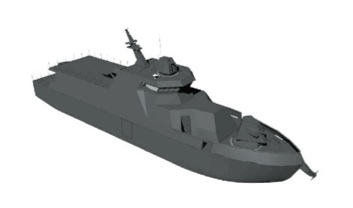Metodología para Optimización Topológica y de Forma de Elementos Estructurales
Palabras clave:
diseño de estructuras, optimización topológica, optimización de formaResumen
El método de los Autómatas Celulares Híbridos (HCA) para optimización topológica simula el proceso de adaptación funcional en estructuras óseas. El método HCA combina la técnica de los elementos finitos para análisis estructural con el paradigma de los Autómatas celulares (CA) para el diseño y ha demostrado ser una técnica efectiva para optimización topológica en estructuras continuas. En este trabajo se integra el método HCA con un algoritmo de optimización de forma que utiliza programación cuadrática secuencial. La geometría optimizada topológicamente es utilizada para construir un modelo bidimensional sólido aplicando un algoritmo de detección de bordes en imágenes y esplines paramétricos. Un ejemplo de una estructura Michell es presentado. También es presentada la aplicación de un algoritmo de optimización de forma en el diseño de unos aligeramientos en las varengas de un buque patrullero fluvial diseñado por COTECMAR. En ambos casos una apreciable reducción del peso fue obtenida.Descargas
Referencias bibliográficas
ALLAIRE, G. Shape Optimization By the Homogenization Method. Springer, 2001.
AMERICAN BUREAU OF SHIPPING,. Rules for building and classing. Steel vessels for service on rivers and intracoastal waterways. ABS, 2007.
ANNICCHIARICO, W., AND CERROLAZA, M. Finite elements, genetic algorithms and beta-splines: a combined technique for shape optimization. Finite Elements in Analysis and Design 33 (1999), 125–141.
ASTM STANDARD A 131/A 131M 2004,. Standard Specification for Structural Steel for Ships. ASTM, DOI: 10.1520/A0131_A0131M-04, www.astm.org, 2004.
BENDSOE, M. P. Optimal shape design as a material distribution problem. Structural and Multidisciplinary Optimization 1 (1989), 193–202.
CANNY, J. A computational approach to edge detection. PAMI 8 (1986), 679–698.
CEA, J., GARREAU, S., GUILLAURME, P., AND MASMOUDI, M. The shape and topological optimizations connection. Computer Methods in Applied Mechanics and Engineering 188 (2000), 713–726.
CHIANDUSSI, G., GAVIGLIO, I., AND IBBA, A. Topology optimization of an automotive component without final volume constraint specification. Advances in Engineering Software 35 (2004), 609–617.
GIVOLI, D., AND DEMCHENKO, T. A boundary-perturbation finite element approach for shape optimization. International Journal for Numerical Methods in Engineering 47 (2000), 801–819.
GONZALEZ, R., AND WOODS, R. Digital Image Processing. Prentice Hall, 2002.
HÄUßLER, P. Topology and shape optimization methods for cfd problems. In CADFEM Users’ Meeting, Fellbach (2006).
KEGL, M., AND BRANK, B. Shape optimization of truss-stiffened shell structures with variable thickness. Computer Methods in Applied Mechanics and Engineering 195 (2006), 2611–2634.
MACHADO, G., AND TRABUCHO, L. Some results in topology optimization applied biomechanics. Computers & Structures 82 (2004), 1389–1397.
MACKERLE, J. Topology and shape optimization of structures using fem and bem. a bibliography (1999 - 2001). Finite Elements in Analysis and Design 39 (2003), 243–253.
MICHELL, A. The limits of economy of material in frame-structures. Philosophical Magazine 8 (1904), 589–597.
PEREIRA, J., FANCELLO, E., AND BARCELLOS, C. Topology optimization of continuum structures with material failure constraints. Structural and Multidisciplinary Optimization 26 (2004), 50–66.
ROZVANY, G. Aims, scope, methods, history and unified terminology of computer aided topology optimization in structural mechanics. Structural and Multidisciplinary Optimization 21 (2001), 90–108.
SIGMUND, O., AND TORQUATO, S. Design of materials with extreme thermal expansion using a three-phase topology optimization method. Journal of the Mechanics and Physics of Solids 45 (1997), 1037–1067.
TANG, P., AND CHANG, K. Integration of topology and shape optimization for design of structural components. Structural and Multidisciplinary Optimization 22 (2001), 65–82.
TOVAR, A. Optimización topológica con la técnica de los autómatas celulares híbridos. Rev Int Mét Num Cálc Dis Ing 21 (2005), 365–383.
TOVAR, A., GANO, S., MASON, J., AND RENAUD, J. Optimum design of an interbody implant for lumbar spine fixation. Advances in Engineering Software 36 (2005), 634–642.
TOVAR, A., PATEL, N., NIEBUR, G., SEN, M., AND RENAUD, J. Topology optimization using a hybrid cellular automaton method with local control rules. Journal of Mechanical Design 128 (2006), 1205–1216.
YILDIZ, A., ÖZTÜRK, N., KAYA, N., AND ÖZTÜRK, F. Integrated optimal topology design and shape optimization using neural networks. Structural and Multidisciplinary Optimization 25 (2003), 251–260.
ZHANG, X., RAYASAM, M., AND SUBBARAYAN, G. A meshless, compositional approach to shape optimal design. Computer Methods in Applied Mechanics and Engineering 196 (2007), 2130–2146.

Descargas
Cómo citar
Número
Sección
Licencia
The authors who publish in this Journal certify that:
- The work submitted for publication in The Ship Science and Technology journal, was written by the author, given that its content is the product of his/her direct intellectual contribution.
- All data and references to material already published are duly identified with their respective credits and are included in the bibliographic notes and quotations highlighted as such.
- All materials submitted for publication are completely free of copyrights; consequently, the author accepts responsibility for any lawsuit or claim related with Intellectual Property Rights thereof, Exonerating of responsibility to The Science and Technology for the Development of Naval, Maritime, and Riverine Industry Corporation, COTECMAR.
- In the event that the article is chosen for publication by The Ship Science and Technology journal, the author state that he/she totally transfers reproduction rights of such to The Science and Technology for the Development of Naval, Maritime, and Riverine Industry Corporation, COTECMAR.
- The authors retain the copyright and transfer to COTECMAR the right of publication and reproduction of the work which will be simultaneously subject to the Creative Commons Attribution License (CC - BY), which allows the license to copy, distribute, display and represent the work and to make derivative works as long as it recognizes and cites the work in the manner specified by the author or licensor.
- For more information about the Creative Commons Attribution License (CC -BY) and his use and scope, please visit the following web page https://creativecommons.org/licenses/by-sa/4.0/legalcode








